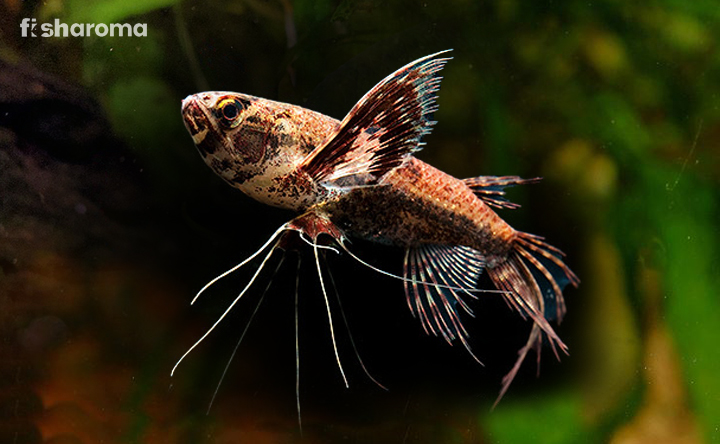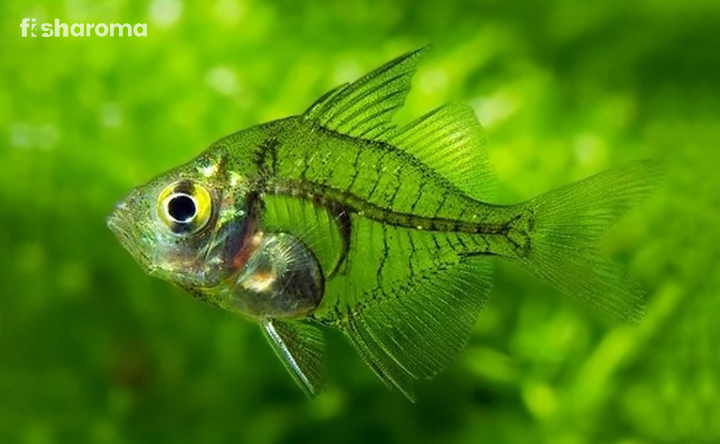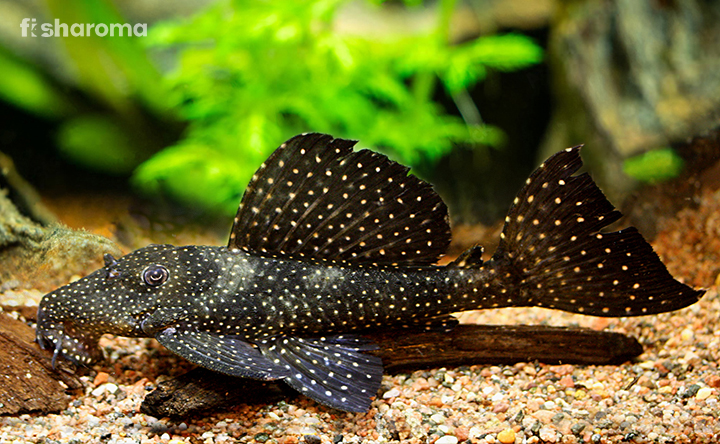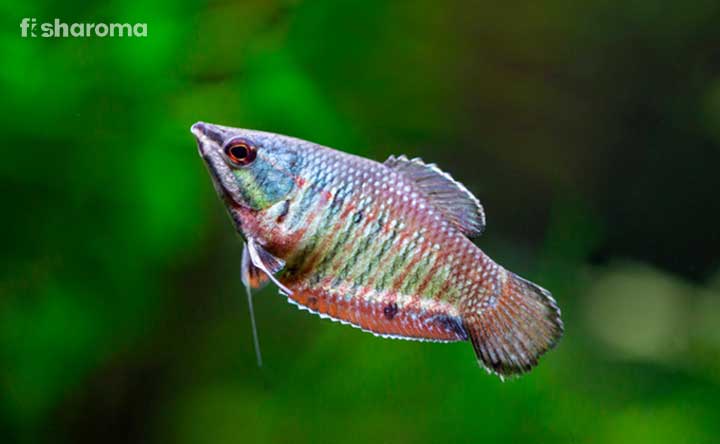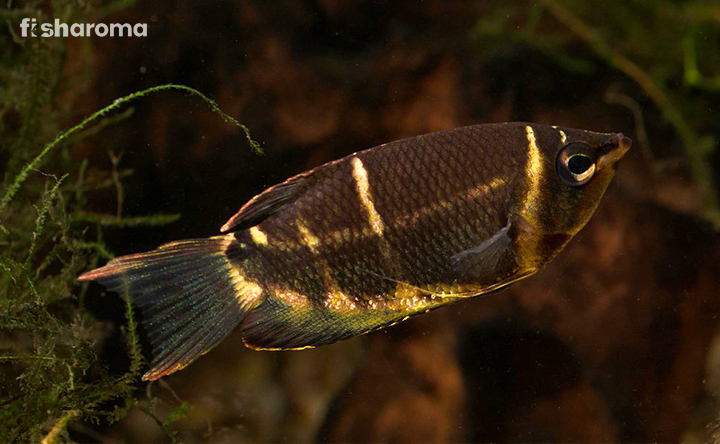Oscar Fish – The Complete Care Guide of This River Dog
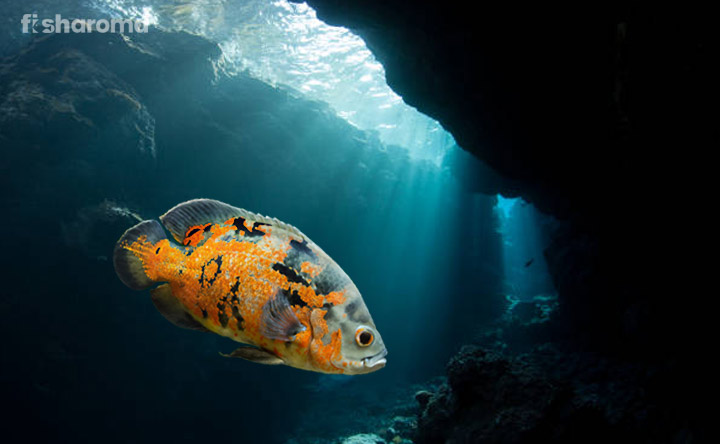
- Origin and Habitat of Oscar Fish
- Appearance of Oscar Fish
- Behavior of Oscar Fish
- Types of Oscar Fish
- Lifespan of Oscar Fish
- Diet of Oscar Fish
- Tank Requirements of Oscar Fish
- Water Type for Oscar Fish
- Compatibility of Oscar Fish
- Breeding of Oscar Fish
- Common Diseases of Oscar Fish
- Difficulties in Petting the Oscar Fish
- Summary
We all know that hosting a beautiful fish elevates the aesthetics of our tank, but when that beauty is combined with an intelligent brain, we end up with a mesmerizing fishkeeping experience. Oscar fish is one such species. Because of its temperament, it is called an odd choice, but it is less difficult than you imagine. Through this article, we will be assisting fish keepers to raise Oscar Fish healthily by maintaining all its requirements.
Key Specifications of Oscar Fish
Take a quick look at the key specifications of this fish before going in its detailed care guide:
| Scientific Name | Astronotus ocellatus |
| Family | Cichlidae |
| Origin | South America |
| Size | 12-16” (30-40cm) |
| Color | Depends on the variant |
| Care Level | Difficult if kept more than one but easy if kept single |
| Lifespan | Up to 20 years |
| Temperament | Extremely aggressive |
| Compatibility | Very low |
| Tank Size | Minimum 55 gallons |
| Diet | Omnivore |
Overview
It is a beautiful and intelligent fish, and most of the time it is kept by experienced fish keepers. It is also known as Velvet Cichlid and Walnut Cichlid. Due to its intelligence and extraordinary relationship with the owner, they are also called the Dog Fish or the River Dogs. There is a large variety of colors of this fish, and that’s why, they are called the Peacock Cichlid, but later, a separate species (Aulonocara) of the same name (Peacock Cichlid) was found from the Malawi Lake, so Peacock Cichlid is not a popular name for Oscar Fish at present.
Origin and Habitat of Oscar Fish
Oscar Fish is available in large numbers in almost all the South American countries like Ecuador, Peru, Brazil, French Guiana, and Columbia. In simpler words, they are available in the whole river basin of Amazon. Along with that, you can see their different variants are available in Paraná River, Rio Negro, and Paraguay River.
At present, the demands of this fish are increasing globally and using different breeding techniques, they are available in entire North America (especially in Florida) and some Asian countries. The fish keeping industry of China is producing them in a huge number each year. For the last few years, they are available in Australia too.
Appearance of Oscar Fish
Look wise, it is beautiful and colorful, and it shares the same structure with most of the other North American Cichlids. It has a round tail along with bright colors and patterns in its body. Their fins are sometimes of a single color, and in some other variants, fins can be seen in different shades and patterns. Their dorsal and anal fins are extended towards caudal fin. Male and female fish have a similar structure, and it is really difficult to distinguish them.
Size of Oscar Fish
The size of newly hatched fries is 1-2” (2.5-5 cm). It is seen that Oscar Fish, in its growth period, grows 1” each month. But it needs a proper diet to grow at this rate. A matured one is 12-16” (30-40 cm), and a hatched fry takes 1 to 1½ year to obtain this size.
Color of Oscar Fish
Oscar fish are available in different colors and patterns. The most popular ones are found in the contrast of black with reddish-orange, solid red, blue with yellow, and so many.
Behavior of Oscar Fish
Oscar Fish swim close to the aquarium wall, and they are pretty active. At the time of swimming in the mid-level of the tank, they are seen to lower their head towards the substrate and search for food particles. They can harm the aquatic plants and decors during this process.
At the time of mating, you can also see their aggression. Delay in feeding will also show their aggression. These are the negative points of this fish; now let’s have a look at the positive sides:
After the stress of initial days, they start getting used to the aquarium, and they become curious about everything happening around them. Gradually a bond between the fish and its owner can be seen.
They are generally peaceful, and the fight for territory can be seen only if you put more than one in an aquarium. Choosing the right tank mates will help to control their aggression.
Types of Oscar Fish
Initially, they are available in three colors, but due to cross-breeding, multiple colors, shades, spots, and patterns are now found in them. Based on the color and patterns, these ten are the most popular variants of Oscar Fish:
Tiger Oscar Fish

From its name, it is clear that it has tiger-like patterns on its body and truly the combination of reddish-orange and black will give you the aesthetic feel of petting a water-tiger. Orange rim in their eyes enhances their beauty. When it swims, it looks much like lava rock.
Albino Oscar Fish

The Oscar Fish of this type has a pinkish-white body with reddish-orange patterns on its lower body. This reddish-orange pattern varies from individual to individual.
Red Oscar Fish

This Oscar Fish has a combination of black with fiery red color throughout its body. In some parts of its body, these two colors mix up and create different textures and gradients.
These are the pure Oscar variants and following are the crossbred ones:
Florida Oscar Fish

This one is a look-alike of Tiger Oscar Fish, but the black and orange colors are found in darker tones in Florida Oscar Fish. Due to poor water quality, this color can turn into pale yellow.
Veil Tail Oscar Fish

These are a popular type of Oscar Fish due to their see-through tails. Their body has a combination of black and reddish-orange. Towards their heads, the reddish-orange patterns become smaller like the dots and towards the eyes; you can see its head in solid black with no pattern.
Blue Oscar Fish

It will at once intensify the look of your aquarium with different shades of blue with different shades of yellow patterns. Towards the tail, the color gets darker, and towards the head, the blue becomes white.
Black Oscar Fish

The color combination of this one is simple yet very beautiful. Dark black is found towards the head and tail, and in between, there are different patterns of black and grey. The color of the belly is generally light, and you can find orange patches too.
White Oscar Fish

These are the look-alike of Albino variants with a pinkish white body. Towards the tail sometimes the color has an orange tone and sometimes it is pale pink. It looks stunning in color-changing LED lights.
Lemon Oscar Fish

It also looks like the White or Albino variant, but a close look will reveal a pale yellow gradient in its body. Proper feeding may intensify this color in lemon yellow color.
Green Oscar Fish

With the right selection of aquatic plants, you can opt for this one for its exceptional color combination. Green body with yellowish black patterns makes it an eye-candy for fish-keepers.
Lifespan of Oscar Fish
They can survive up to 20 years if proper aquarium and water adjustments are provided. It will be better to breed this species at the age of 1 to 2 years as they get matured at this age.
Diet of Oscar Fish
They have an omnivore diet from the very beginning, which means that you will have a wide choice of foods for them. As they are quite large, you need to include high protein foods for them. So, the inclusion of live foods is mandatory for them. These are the food options for them:
- Tetra Cichlid Crisps
- Hikari Tropical Wafers
- Plant debris
- Fresh fruits
- Algae or green plants
- Frozen Fish
- Insect Larvae
- Aquatic Invertebrates
- Freeze Dried Worms
- Freeze Dried Veggies
- Mealworms
- Small Minnows Like Rosy Red Minnows
- Freshwater Crustaceans
- Krill
- Daphnia
- Brine Shrimp
- Bloodworm
- Feeder Fish Like Goldfish
- Cichlid Pellets
- Feed only once a day, and the quantity of food should be what can be consumed within two minutes.
- Look for the uneaten foods and remove them.
- Feed the adults four days a week if you think you have overfed the fish.
Also, they have a hunting instinct which is seen during feeding live foods. If you constantly skip the plant materials from their diet, you will see them turn into carnivores. The planktons will supply vitamin C and fibers, which will keep them healthy while insects and fish protein will make your fish energetic. Probiotics of dried foods will cure them of bloat, blockage, and constipation, so don’t ever skip these dry foods. Beware of the parasites and infections in the live foods which will make your fish sick.
Tank Requirements of Oscar Fish
In order to grow a healthy Oscar Fish, strict aquarium adjustments are needed. Take a look:
Tank Size
As this fish is a bit large, a 55-gallons tank will be very appropriate for them. For a pair, the size should be 125-gallons.
Tank Lid
They are known for their jumps, so don’t even try to keep your aquarium uncovered even if your fish is young.
Substrate
They prefer to dig holes in the substrate, and a soft substrate such as sand is required for that. You can use small rocks along with bogwood. You can place caves from which they can ambush their prey.
Aquatic Plants
Plants can be uprooted due to their aggression, so it will be better to avoid them. Still, if you want to use aquatic plants, floating plants such as Hornwort will be ideal. They will never eat the plants, but by uprooting the plant from the substrate, they will kill them.
Filter
A filter will be required to produce a strong current which is much preferred by them. Filters will also clean the tank and keep them healthy.
Lighting
Fluorescent light or LED light will give the best look to your tank with this fish.
Water Type for Oscar Fish
Water adjustments are also mandatory for this fish as they will be weaker due to a slight mismatch in their water type.
Temperature
Water temperature should be between 74-81°F (23-27°C), with 77° F (25° C) being the optimal point.
pH Level
pH level should be between 6 to 8. Above 8 will be extremely harmful to them.
Hardness
5-20 KH is the acceptable hardness level for them.
Nitrate Level
Nitrate levels should be reduced to zero for their healthy growth.
Cleaning Methods
Clean without using chemicals. Siphon out the uneaten foods manually.
Replacement Procedure
Partial cleaning will be alright here. As it requires bigger tanks, 10-15% water change each week will be good.
Compatibility of Oscar Fish
Keeping them in odd numbers in the tank will be risky as bonding between two will be good, and the odd one will be traumatized. Keep in mind to put the Oscar Fish of the same size together because they will hurt smaller ones due to extreme aggression.
Suitable Tank Mates of Oscar Fish
It is not at all good at making friends but keeping larger fish with them is comparatively safer. Suitable tank mates are:
- Jack Dempsey
- Black Pacus
- Large Plecostomus
- Jaguar Cichlid
- Firemouth Cichlid
- Severum Cichlid
- Chocolate Cichlid
- Convict Cichlid
- Arowanas
- Green Terror
- Black Convict
- Silver Dollar
- Bichir
As the Oscar Fish is large, you will need to select a larger tank (approximately 200-gallons) to keep these suitable tank mates. A large tank will reduce the chance of territorial fight too.
Unsuitable Tank Mates of Oscar Fish
Any small fish are unsuitable tank mates for them. Slow swimmers and bottom-dwelling fish are to be avoided here. The most unsuitable tank mates are:
- Fancy Goldfish
- Neon Tetra
- Celestial Pearl Danio
- African Cichlid
- Molly
- Guppy
- Cherry Barb
- Shrimp
- Crab
- Snail
Breeding of Oscar Fish
Breeding is difficult as they are very selective in choosing their mates. Growing the male and female together in the same tank can be helpful here. When they are 1 to 2 years old, you can start replicating their natural breeding requirements. In order to indicate the rainy season, you can lower the temperature of the aquarium.
When fish are ready to spawn, they signal their mates by waggling their fins. At this time, a large tank is required so that they can swim and continue their sport. The couple will search clean rocks so that the female can lay eggs on that. Females lay almost 3000 eggs which are nurtured and nourished by both males and females until hatching.
The eggs take 2-3 days to hatch, and after hatching, transfer them to a separate tank; otherwise, the adult ones will eat them.
Common Diseases of Oscar Fish
It is a rare case to see an Oscar Fish falling sick; however, an improper tank condition or diet can lead to various diseases in them.
| Diseases | Symptoms | Causes | Remedy |
| Hole in the head | 1. White sores with mucous on the head. 2. No appetite. | 1. Parasite Hexamita. 2. Poor water quality. 3. Vitamin or mineral imbalances. | 1. Add Flagyl in an aquarium. 2. After 24 hours, add formalin and malachite green in the aquarium. |
| Bloat | 1. No movements in the bowel. 2. A bloated appearance of the fish. 3. Uncontrolled swimming. | 1. Overfeeding. | 1. Increase in temperature. 2. Feed well-cooked pea. |
| Columnaris | 1. Fins are blackened. 2. Floating on the surface. 3. Lethargy. | 1. Bacterial infection. 2. Low oxygen in the water. 3. Overcrowded aquarium. | 1. Use antibiotics like Tetracycline and Oxytetracycline. 2. Apply aquarium salt. 3. Partial (20-25%) water change. |
| White Spot | 1. Fins and tail turn red. 2. Lack of appetite. 3. Rubs its body against aquarium objects | 1. A protozoan parasite called Ichthyophthirius multifiliis. | 1. Increase the water temperature. 2. Use aquarium salt. 3. Apply Copper sulfate |
| Popeye | 1. Bulging eyes | 1. Dirty water | 1. Water change. 2. Use aquarium salt |
Difficulties in Petting the Oscar Fish
In terms of diet, it is definitely not a difficult one to pet, but yes, due to its temperament, it is not friendly with small fish. Also, strict water and aquarium adjustments are needed for them. You have to go through routine cleaning of tank and water changes to keep the fish healthy. You need to put in some efforts which will be reflected in the health and color of your fish.
Summary
So if you want a pet fish that will swim round and round whenever you come in front of the aquarium, and jump to eat the food directly from your hand, you have to get Oscar Fish. It is a loyal pet fish that feels delighted just to see you and makes an innocent face like the dogs when hungry. Also, it will react to any sound in your room and entertain you with an amicable attitude and cute interactions through the aquarium wall. So, let us skip its negative side of aggression and pet this majestic species!
Interesting facts
- In case Oscar Fish finds its owner is not there for a long time, it feels lonely and hides in the caves. As soon as it sees the owner, it swims happily across the tank.
- If you keep a group of Oscar fish, you will find that they have an extraordinary sleeping style. Some of them close their eyes during sleep and some other sleep with open eyes.
- In order to hide from enemies, they often camouflage themselves in the wild.
Some More Exceptional Freshwater Fish and Their Care Guide:
If you want to pet a different fish in your freshwater aquarium, you will find these articles very interesting:
- Iridescent Shark: If you want to get a pat on your back, pet a look-alike of shark. Know about the diet, water and tank requirements of Iridescent Shark.
- Red Tail Shark: The name shark is enough to have a good impression, right? Pet the Red Tail Shark with easy guidelines.
- Black Ghost Knifefish: A mystic pet fish that will add to the charm of your freshwater aquarium. Know how to raise them healthily.

